Renown Auto Restoration Blog
Wet Sanding and Buffing... What Is It and Why Do We Do It?
Generally speaking, when we talk about wet sanding an buffing in the automotive environment, we are looking to get the absolutely best shine out of the paint finish on a car or truck. We are looking to get a true show car finish. To help with this I have the diagram below which shows a surface that is not perfectly flat vs one that is. This is NOT to scale, but it is representative of the surface of a car after it has been painted. (Click on Continue reading to for more information and some impressive photos that show this process.)
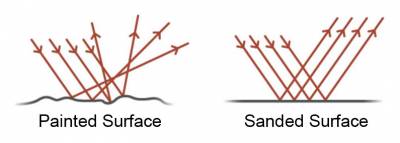
When paint is applied it goes on in thin layers, and many times we put multiple layers, or coats, of paint on a car. You may be familiar with the term "base coat/clear coat." This is were you paint the color, the base coat, followed by a clear coat. If we know we are going to be wet sanding a car we will put multiple coats of clear to provide enough material to allow for sanding without going through the clear to the base color underneath.
In the diagram above we show how light is reflected off an irregular surface, and how it is reflected off a smooth, sanded surface. If you look at a brand new car, and look very closely, you will see very small (VERY SMALL) waves in the paint. This is normal. It has to do with how the paint falls on the surface and how it dries. This irregularity is quite small. We call this orange peel, because if you magnify it it will look similar to the peel of an orange.
Wet sanding is a process where we use special sandpaper that is supposed to be wet with water. Very wet. The water acts like a lubricant plus helps remove tiny particles so that the sandpaper does not get clogged and create deep scratches. Granted, the act of sanding does create small scratches. However we use finer and finer grits of sandpaper to make those scratches smaller and smaller as we get the finish as flat as possible. Here is a photo of a Firebird being wet sanded. Notice the blue towel that is being used to continue to drip water over the surface as it is sanded. (You can click on the image to see a larger version.)
This is NOT something you want to do in your driveway on the weekend. Our team will spend 60-70 hours on one car (maybe more if it is a larger car). This Firebird was wet sanded 6 times. That's right, 6 full times over the entire body of the car, once each with the following grits of paper: 1000, 1500, 2000, 2500, 3000 & 5000. 5000 grit sandpaper will feel light notebook paper to the average person. But in the hands of a skilled person, it gets the finish as smooth as possible.
Once the sanding is complete, then we perform a 3 stage process to buff the car. This is where we have a buffing wheel on a machine that we can control the speed, and proceed to buff the entire car 3 times, each time using a finer and finer buffing compound. Then we finish the entire car off with a polishing glaze.
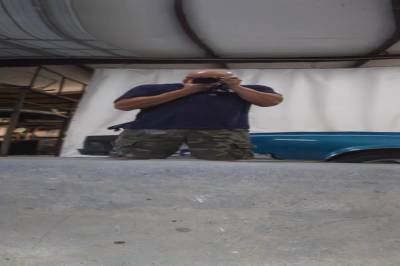
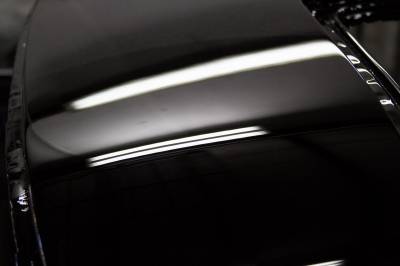
(Click on images to see larger versions)
The results are a true show quality finish that is better than any new car manufacturer can provide. It is stunning to see in person. I took a "selfie" in the door of the Firebird (above left) after it was finished. Notice that the door is curved with a crease in the middle. The top half of the photo is me. You can see the color of my shorts and shirt, and you can see the blue car behind me. The bottom half is actually the floor reflected in the bottom half of the door. On the right is a closeup of a reflection of the lights in the shop reflected in the roof of the car. Notice how straight those lines are. Try this at home. If you have long florescent tube lights in your garage, look closely at their reflection in your own car's paint. You will see the tiny irregularities we are removing with the process.
The results are quite impressive. When done right you can't beat it. It is critical do have this done correctly. Remember, our technician went over this car 9 times with sandpaper and buffing compounds. Any one of those times he could have gone "too far" and ruined the paint. Of course he did not, but if you try this at home be careful. Here are a couple of shots of the car just after the final buffing.
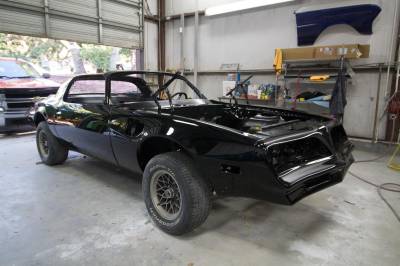
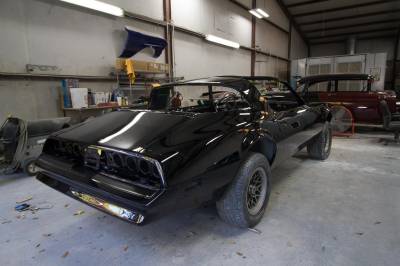
(Click on images to see larger versions)
I have described this process in detail because I understand the science behind it. However, to actually do this is much more of an art form. Let our team of experienced people do this for you. Don't risk your paint job when you don't have to.
When you subscribe to the blog, we will send you an e-mail when there are new updates on the site so you wouldn't miss them.
Copyright © Renown Auto Restoration. All Rights Reserved. Website by The Ousset Agency
